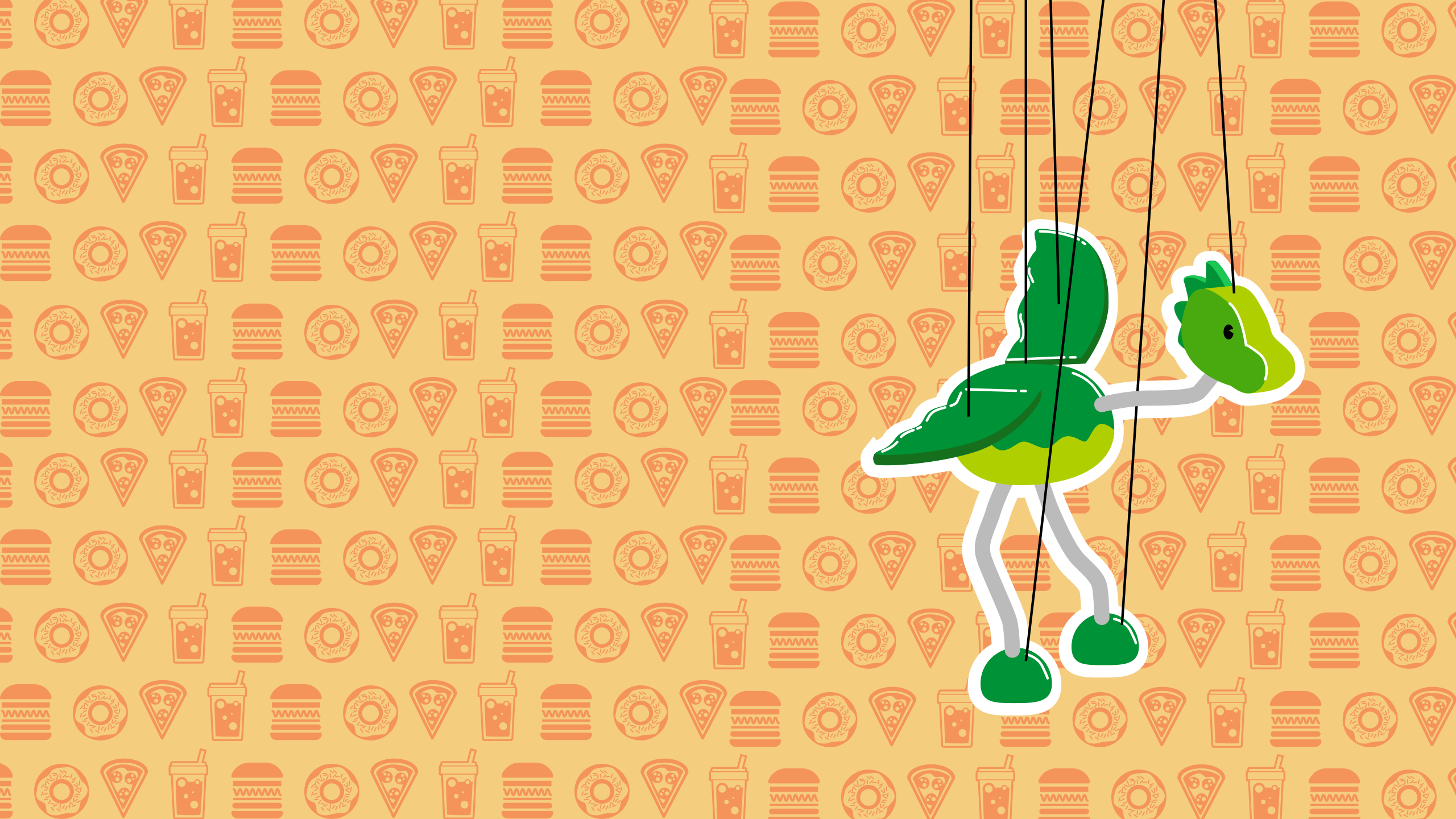Why we just can't stop eating
Obesity is often characterised as nothing more than greed and lack of willpower. The truth is far more complex.

It’s just after midday and Cambridge market is getting steadily busier. Students, workers and tourists mingle among the densely packed food stalls, craning to see what is on offer and forming polite, if somewhat disorderly, queues.
Lunchtime here is an embarrassment of riches, a festival of international cuisine: Korean bibimbap, Lebanese falafel, Venezualan arepa, Brazilian feijoada, Indian biryani, Spanish paella. Head out of the market and the range broadens to Mexican burritos, Japanese sushi and Thai curry.
Britain has seen a dramatic transformation in recent years in its attitude towards food. We have gone from being a country ridiculed for its bland, carb-heavy cuisine, for whom the chicken tikka masala was the height of exoticness, to becoming a nation obsessed with food. We cannot get enough of international cuisine – and not only pizza and curry, but sushi, chorizo and hummus. Our bookshelves creak with the latest celebrity and food fad cookbooks. And when we’ve finished eating, we enjoy nothing more than watching competitive cake baking and sniggering at ‘soggy bottoms’.
But alongside this obsession with food has come a growing understanding of the impact that our diet has on our bodies – not only on our waistlines, but also on conditions such as diabetes, heart disease, cancer, and even dementia. According to the official Health Survey for England in 2016, more than a quarter of adults were obese. A recent report from the Local Government Association suggested that one in 25 children in England aged 10 or 11 is severely obese.
This relationship between our diet and our weight is simple: you eat too much, you get fat. Hence, some would argue, the solution should be equally simple: you eat less, you lose weight.
If only it were this easy. Anyone who has tried to shed a few pounds – and, crucially, to keep them off – knows that the answer is rarely so straightforward. In fact, even the food – and volume – that we ‘choose’ to eat is influenced by a surprising number of factors.

A gut feeling
How do we know when we've eaten enough?

Sitting at one end of Addenbrooke’s Hospital, at the heart of the Cambridge Biomedical Campus, is the Wellcome-Medical Research Council Institute of Metabolic Science (IMS). The institute, jointly led by Professors Sir Steve O’Rahilly and Professor Nick Wareham, is dedicated to exploring these factors, trying to understand what drives us to overeat and the impact that overconsumption has on our bodies.
Husband and wife team Professor Fiona Gribble and Dr Frank Reimann, both researchers at the Institute, have spent their careers investigating a question at the heart of this problem: how do we know when we are full? Their focus is on the gut and the signals it sends out when we eat.
“The gut has a hormonal system that’s embedded in the epithelial lining,” explains Gribble. “As the food is being absorbed through the epithelial layer, hormones are released that should be proportional to how much has been eaten and how much is being absorbed.”
These hormones signal to the brain, telling us to stop eating, and to the pancreas to prepare it to deal with an expected rise in blood sugar. They also help coordinate the movement of the food through the digestive system. “When you’ve eaten a meal, you don’t want all the food whistling through the stomach and coming straight out the other end without having been absorbed,” she says.
The importance of gut hormones in influencing how we respond to food can be clearly seen in people who have undergone gastric bypass surgery. This operation removes a small part of the gut and rearranges the remainder; it doesn’t physically restrict the amount someone can eat, but causes food to be absorbed further down the gut, changing the profile of the hormones that are released.
“People come out of surgery and they want to eat different things, and they don’t want to eat as much,” says Gribble. “It’s difficult therefore to say that your brain is completely in charge of everything you eat.”
One of the key hormones of interest is known as GLP-1. Ordinarily, levels of this peptide increase two-fold after a meal – after gastric bypass surgery, the amount increases as much as 20 times. Drugs based on GLP-1 have been licensed for type 2 diabetes, and were also recently introduced onto the market for treating obesity.
Gribble and Reimann are trying to understand the hormone-releasing gut cells, and in 2008 developed the first transgenic mouse models that would allow them to carry out such research. When they started, theirs was the first lab of its kind doing such work. “For the first few years, people looked at us and said ‘We’ll hang on in the side-lines and see if they make it work’,” she says. Now, many more research groups, inspired by their work, are working in this area.
The ‘Holy Grail’, adds Gribble, would be to find a drug that can mimic bypass surgery, possibly by stimulating cells in the gut. Progress has been slow, she admits, emphasising the complexity of the problem, but she is very optimistic that this is achievable.
“If it wasn’t for the fact that bypass surgery is so effective, I think I would have given up! But the fact that it’s the best treatment for obesity and the best treatment for diabetes says that there’s something fundamental there that we should be able to understand and mimic.”
Gribble’s colleague Dr Florian Merkle is interested in the next step in the chain of events that lead to appetite regulation: what happens in the brain? His focus is on the brain cells that regulate appetite. Many of these cells are found in the hypothalamus, a region of the brain that controls the release of hormones and regulates important behaviours, such as feeding.
In particular, he is interested in a cell type known as the proopiomelanocortin (POMC) neuron: a fault in the POMC gene can be sufficient to cause some individuals to become severely obese. Merkle studies how these cells sense the amount of energy available – how recently we ate, for example, and how much fat we have stored – and how they use this information and in turn signal to other cells.
Like Gribble, Merkle works with mouse models, but they have their limitations, he says. “Mice enable beautiful studies which demonstrate that a genetic fault or specific cell population can influence how much mice eat, how much energy they expend, their change in body weight, etc. – but we sometimes have a hard time connecting the line between the genetic fault and the animal’s behaviour. There’s a ‘black box’ in between.”
Merkle says that the answer may be to examine how a genetic fault causes cells such as POMC neurons to behave differently at a molecular level.
But there’s an additional problem, too: mice are not humans. While our genetics and physiology are similar enough that mice can tell us a lot about how our bodies work, there are important functional differences between our two species. This is especially important when we examine how genetic faults associated with human obesity might contribute to defects in cells – many of the faults simply cannot be modelled well in animals.
To get around these problems, Merkle is working with stem cells, which can develop into almost any type of cell within the body. Merkle has developed a way of taking stem cells and specifically guiding their development so that they produce nerve cells like those found in the hypothalamus. These can be genetically-manipulated to test how they respond to hormones such as leptin, which is produced by our fat cells to tell us how much energy we have stored. They can also be used to test their responsiveness to current drugs in use for obesity and diabetes, and to screen for new drugs.
“Fighting the biological urge to eat is a losing battle by itself,” he says, “but, if in addition to improving physical activity and improving diet, we are able to give pharmacological treatments that reduce the power of those hard-wired urges by correcting obesity-associated defects in brain cells, there is real potential for benefit to patients.”

Healthy eating
for two
Breaking the vicious cycle of overeating

Quite how much of an uphill battle we face is driven home by Professor Susan Ozanne. Her work focuses on how our long term health is influenced by our mother’s diet during pregnancy. By feeding pregnant mice a diet high in fat and supplemented with condensed milk, she has shown that if the foetus has access to an overabundance of nutrients in the womb, this somehow programmes the hypothalamus, altering the neuronal connections and signals between the brain cells that would normally tell us we’re full.
In other words, if the mother overeats during pregnancy, this ‘programmes’ her offspring to overeat and the child grows up to overeat and become obese… “It’s a vicious cycle as when the female child becomes pregnant her baby will also be exposed to an environment in the womb that puts it at risk of obesity,” says Ozanne. “We need to break that cycle.”
Encouraging the mother to exercise during pregnancy might help, she says, even if they don’t lose weight, which is surprisingly difficult once you’re already obese; the aim is to improve their ‘metabolic fitness’, the body’s ability to cope with sugar in the blood.
Of course, this does not mean that diet is not important. “Diet at any stage of life is important, but diet during pregnancy is particularly important. It impacts not only on the health of the woman but also on her children and grandchildren and potentially further.”
Fathers are not let off the hook, either, she says. There is evidence that his diet can have an impact on his sperm, and hence on his offspring. “It’s both dad and mum who should be trying to be as healthy as possible.”
All this suggests that the old adage ‘eating for two’ should be put to bed. “More and more, we know that’s not the mind-set that we should have,” Ozanne says. Instead, she suggests a way to turn the phrase around. “You can almost view it as ‘I’m eating for two, so I need to make sure that what I’m eating isn’t just good for me but is good for my baby’.”

Who pulls the strings?
It's time to put an end to the 'blame game'

Despite fairly incontrovertible evidence that no one factor leads to obesity, there are many people in society who have little sympathy for those who overeat. In August 2017, Daily Mail columnist Amanda Platell made clear where she thought responsibility lay.
“It’s greed that makes you fat. Not ignorance about the dangers of junk food,” she wrote, piling on the insults. “Fatties lack the willpower to stop eating. Reduce the burger size and the Billy Bunters after instant gratification will just order two, with extra chips.”
“Blaming people for their obesity is never helpful,” counters Professor Sadaf Farooqi. “It is a complex problem. It is not simply just about people choosing to eat too much or to not do enough exercise.”
Farooqi’s own work has focused on the genetics of obesity. Her work with children who are severely obese due to genetic faults has led to an understanding of the importance of the hormone leptin in regulating appetite (and hence body weight). It has also helped prove that severely obese children are not necessarily the victims of careless – or worse, potentially abusive – parents, but rather are ‘victims’ of their own DNA. This has helped find a treatment to reverse their obesity and, in several cases helped prevent the children being taken into care.
It would be unfair – and completely inaccurate – to characterise these children as greedy or lacking willpower.
In fact, attitudes such as those voiced by Platell may come down to what psychologists refer to as the ‘fundamental attribution error’ – the assumption that behaviour is directed entirely by what goes on in our head.
“There’s a general notion that the brain is a puppet master that controls everything and as a consequence of rational, balanced, processes that go on in the brain, we make our decisions and we carry out our actions,” says Professor Paul Fletcher from the Department of Psychiatry. “But the reality is the brain is a slave to the environment and to what’s going on in the body. It’s this three-way interaction, between the body, the brain and the world, that’s shaping our behaviour.”

Size matters
The cues in our environment that encourage overeating

The IMS’s new Translational Research Facility, recently opened with funding from Wellcome, will be uniquely placed to investigate understand how these three elements influence our diet. Fletcher is one of the collaborators in the facility. It is led by Farooqi.
“The new facility allows us to do more research in a state-of-the-art environment and to open our minds – to do the kinds of research that we couldn’t do before,” she says. One example is a study not of obese people, but rather of healthy thin people – people that everyone knows, who can eat whatever they like but never gain weight. What is it about their DNA and their bodies that stops them piling on the pounds?
“We think there are genes, but also hormones, that might protect some people from gaining too much weight,” she says. One way to test this is to bring people who are thin but otherwise healthy into the facility and feed them a high fat diet and see what happens. “But you need a facility where you can keep people in a comfortable environment for ten days, where you can control everything about that environment, so that you can make really precise measurements.”
And when she says “control everything about that environment”, this is exactly what she means. “What we eat, when we eat, how many calories we burn, is controlled by many things in our environment. In our facility, we can control light, the temperature of the rooms, what time people eat, the kinds of food they’re given…”
The testing areas are also built to support people who are severely obese, so that they can have a comfortable environment. “It’s quite noticeable now that when we bring people in, they’re immediately at ease because they’re not having to worry how they’ll manage,” she says.
One of the most interesting (and deceptively simple) elements of the facility is its Eating Behaviour Unit. It includes a modern, stylish lounge and dining room that would not look out of place in an Ikea catalogue. But it’s here, says Farooqi, that some of the most interesting work will take place. Study participants may take part in conventional, computer-based tests of cognition, for example, but when the study is ‘over’ they are invited to help themselves to an all-you-can-eat buffet; in fact, this buffet is itself part of the study, allowing the researchers to observe how people behave – why they make particular food choices, for example, or how their plate size influences how much they eat.
In 2016, Farooqi published a study where participants were allowed to help themselves to an all-you-can-eat buffet of the UK’s favourite curry, chicken korma. There were three options, manipulated to look and taste the same, but in which the fat content varied between 20 to 60% of the total number of calories. Despite everyone saying the kormas all tasted the same, participants with a particular genetic defect ate twice as much of the high fat korma as their lean counterparts.
More often, though, it is external factors that influence our food choices. “We are sensitive to very many cues in our environment, often without awareness, that lead us to eat more than we think we have eaten,” explains Dame Professor Theresa Marteau, one of Farooqi’s collaborators at the TRF.
Several of Marteau’s studies have focused on size: the size of our portions, the size of our plates, the size of our wine glasses, for example. Her team led a Cochrane Review – the ‘gold standard’ of meta-analyses, which review all the available evidence – which found that eliminating larger-sized portions from our diets could reduce the number of calories consumed by up to 16% among UK adults or 29% among US adults.
Marteau describes the work that she will be carrying out at the TRF as “virgin territory, really”. It is the idea of doing real world studies – in bars, cafeterias and supermarkets – and then returning to the Eating Behaviour Unit to interrogate what they find, optimise interventions, and then test these back in the outside world.
“The answer at one level is simple: change our environment and you change our behaviour. But then there’s a question of how much evidence is needed to give certainty to the policymaker and for the courts to do battle with the industries that stand to lose by changing these cues in our environment.”
Marteau recently carried out a study in the Pint Shop, a local Cambridge bar, which showed that increasing the size of wine glasses (but not the amount of wine in them) led to people drinking faster and consuming more alcohol. The obvious conclusion: reduce the size of wine glasses and you cut how much people drink.
But this was only one study. Robust evidence requires replication in larger studies. To do much larger, randomised studies, she needs more bars on board, but “trying to engage the commercial sector in our work is terribly difficult,” she says. Fortunately, she has found a useful – and helpful – collaborator in the National Union of Students (NUS), who will offer her team access to around 140 bars across the country.
The NUS bars are quasi-commercial settings, but unlike the commercial sector, she says, are less concerned about a potential drop in alcohol-related takings. “They’re concerned about the health and wellbeing of students, so for them, it wouldn’t be a problem to subtly reduce the amount their students are consuming.”

A complex puzzle
Where should we begin?

In Platell’s attack on the overweight, she takes issue at what she sees as the excuses people make for their weight, including “…they’re obese because they’re poor, and everyone else is to blame for cramming them full of junk food and takeaways”.
But this argument misses the point: of course, we do all choose what to eat, but these choices are much more difficult for people who live in deprived areas, who do not have the same access to healthier food that a middle-class newspaper columnist might.
“It’s often assumed that everyone has equal opportunity to eat healthily if they want to,” says Dr Tom Burgoine from the Centre for Diet and Activity Research (CEDAR). “I think that’s something of a misconception. In terms of food access, some high streets are undoubtedly ‘healthier’ than others.”
Burgoine points to research from his team, which shows that for many people, nearly half of all outlets selling food in their neighbourhood are fast food outlets.
“Fast food is playing more of a role in our lives,” he says. “There are many reasons for this: it’s quick, it’s fast and easy, and it’s often cheap. And importantly, it’s more available than ever on our high streets.”
Something clearly needs to be done, but too often the ‘nanny state’ argument is wheeled out against initiatives that try to steer us in the right direction. Burgoine sees tackling this problem from the opposite direction, however: “It’s about enabling choice, not restricting it.”
His research at CEDAR has shown a transformation on our high streets since 1990: fast food is more accessible than ever and has become more concentrated in deprived areas. This is important because the team has also shown a clear link between living and working near a high number of fast food outlets and a tendency to eat more fast food and to be obese.
What’s more, there is evidence that people from lower socio-economic groups are more susceptible to the effects of living near lots of takeaways. The reasons are likely to be myriad: lower incomes, poorer cooking facilities at home, and a lack of education and nutritional awareness, for example. “Ultimately, those who face a double burden of individual and neighbourhood level challenges to maintenance of a healthy diet and weight are in a particularly tough situation”
This finding may sound obvious – The Sun certainly thought so, branding the researchers “Silly burgers” – but again, it’s about providing evidence to enable policymakers to make changes in the face of resistance from the commercial sector.
Burgoine has now developed an online resource called the Food environment assessment tool (Feat) – “It’s a bit like Google Maps for food access, it gives a clear picture of the whole country and how levels of access to different types of food outlets change from a county level all the way down to a street by street level, and it shows changes over time”.
A key audience for this tool is policymakers, and it is already being used. Wolverhampton City Council introduced a policy restricting planning permission for new fast food outlets in particular areas, for example near schools, drawing on data from Feat for support.
“Local authorities have to be prepared to defend these ideas with evidence and data,” Burgoine says. “These policies are often met with hostility during the implementation process, and later, they’re sometimes challenged by prospective fast food business owners, who take their planning appeals to court. They might say ‘there aren’t that many fast food outlets here at the moment’, or that, ‘one more won’t make a difference’.”
Feat helped Wolverhampton to make their case by demonstrating that, in fact, as a city they are significantly worse than the national average when it comes to the number of fast food outlets per capita.
Burgoine fully accepts that there remains a critical role for personal responsibility in diet, but that healthier choices need to be easier for people to make. He knows too well human tendencies: “I live next door to a Nando’s. I’d never had a takeaway from Nando’s before I moved. But I’ve been in my house four months and I’ve had it four times, because it’s super convenient!”
As the afternoon draws to a close in Cambridge, the food stalls begin packing up, though the fruit and veg stalls will stay open longer as people stop by to pick up supplies for their evening meal. Today has been a brisk day for business: the sunshine has brought out the crowds.
It’s easy to forget, with so much variety available, that not every town or city is as rich in its offerings; even within Cambridge, not every citizen has access to or can afford to take advantage of such diverse and healthy food options.
At times, it seems almost impossible to know where to start to tackle the growing obesity crisis. Complex problems require complex solutions, and few would challenge Farooqi’s assertion that obesity truly is a complex issue.

